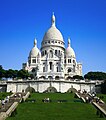Neo-Byzantine architecture
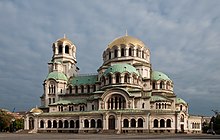


Neo-Byzantine architecture(also referred to asByzantine Revival) was arevival movement,most frequently seen in religious, institutional and publicbuildings.It incorporates elements of theByzantine styleassociated withEasternandOrthodox Christianarchitecture dating from the 5th through 11th centuries, notably that ofConstantinople(present-dayIstanbul) and theExarchate of Ravenna.
Neo-Byzantine architecture emerged in the 1840s inWestern Europeand peaked in the last quarter of the 19th century with theSacré-Coeur BasilicainParis,and with monumental works in theRussian Empire,and laterBulgaria.The Neo-Byzantine school was active inYugoslaviain theinterwar period.
Russian Empire
[edit]Sophia CathedralinPushkin(1782–1788) was the earliest and isolated experiment with Byzantine treatment of otherwiseneoclassicalstructures. In 1830sNicholas I of Russiapromoted the so-calledRusso-Byzantinestyle of churches designed byKonstantin Thon.Nicholas I despised true Byzantine art; Thon's style in fact had little common with it. Notably, Thon routinely replaced the circular Byzantine arch with akeel-shapedgable,and the hemispherical Byzantine dome with anonion dome;layout and structural scheme of his churches clearly belonged to neoclassical standard.
True Byzantine art, popularized byGrigory GagarinandDavid Grimm,was adopted byAlexander II of Russiaas the de facto official style of the Orthodox Church. Byzantine architecture became a vehicle of Orthodox expansion on the frontiers of Empire (Congress Poland,Crimea,theCaucasus). However, few buildings were completed in the reign of Alexander II due to financial troubles.Alexander IIIchanged state preference in favor ofRussian Revivaltrend based on 16th-17th centuryMoscowandYaroslavltradition, yet Byzantine architecture remained a common choice, especially for large cathedrals. Neo-Byzantine cathedrals concentrated in the western provinces (Poland, Lithuania), the Army bases in Caucasus andCentral Asia,theCossack hostsand the industrial region inUralsaround the city ofPerm.ArchitectsDavid GrimmandVasily Kosyakovdeveloped a unique national type of a single-dome Byzantine cathedral with four symmetricalpendentiveapses that became de facto standard in 1880s-1890s.
The reign ofNicholas IIwas notable for the architect's turn from this standard back toHagia Sophialegacy, peaking in theNaval Cathedral in KronstadtandPoticathedral. These designs employedreinforced concretethat allowed very fast construction schedule; their interiors contained clear references to contemporaryArt Nouveauyet the exteriors were a clear homage to medieval Constantinople. Russian Neo-Byzantine tradition was terminated by theRussian Revolution of 1917but was continued by emigrant architects inYugoslaviaandHarbin.
-
The Kazan church,Novodevichy Cemetery,St. Petersburg
-
Ioannovsky Convent,St. Petersburg
-
Exaltation of the Cross Cathedral at St. Nicholas Monastery,Verkhoturye
-
The Orthodox Church inBiałowieża
Southeastern Europe
[edit]Bulgaria
[edit]-
Faculty of Theology Sofia,Sofia University
-
The Sofia Seminary
-
The Palace of the Holy Synod of theBulgarian Patriarchate,Sofia
-
St. Nedelya Cathedral Churchat night, Sofia
-
St. Demetrius Cathedral,Vidin
-
St. Nikolay of Sofia church, Sofia
-
Saints Cyril and Methodius Cathedral,Burgas
-
St. Nikolay the Wonderworker church,Stara Zagora
-
Dragalevtsi Monastery(new buildings from 1932) Sofia
-
Regional History Museum Sofia(former Sofia Central Public Mineral Baths)
-
The building of the New Palace inVrana Palace,Sofia
The Bulgarian Neo-Byzantine style from the end of the 19th and the beginning of the 20th century is often a combination of Byzantine,typical Bulgarian,Eastern Orthodox andSecession/Art Nouveau/Modernismeelements.
- Alexander Nevsky Cathedral, Sofia(1882-1912);
- Dormition of the Mother of God Cathedral, Varna(1882-1885);
- Faculty of Theology (Sofia University) (1908-1912)
- Regional History Museum Sofia, formerSofia Central Public Mineral Baths(1913) - the building was designed in theVienna Secessionstyle, but integrating typically Byzantine, Bulgarian and Eastern Orthodox ornamental elements;
- Sofia Theological Seminary(1902-1914);
- Vrana Palace- the building of the New Palace in "Vrana" is a two-storey massive building, executed in typical Bulgarian style with Secession elements, combined in an elegant Neo-Byzantine spirit.
- Church of St Paraskeva, Sofia(1926-1930)
- St. Nedelya Cathedral Church(10th century, 1933), Sofia
Greece
[edit]- Cathedral of Saint Andrew, Patras(1908-1974)
- Church of Saint Panteleimon of Acharnai,Athens(1910-1930)
Romania
[edit]-
Entrance of the Laurențiu and Louise Steinebach House (Bulevardul Eroii Sanitari no. 18),Bucharest,byAlfred Popper,1915-1916[1]
-
Doctor Ion and Maria Urlățeanu House (Strada Dumbrava Roșieno. 10), Bucharest, byAlfred Popper,1922-1923[3]
-
Strada Pictor Constantin Stahi no. 18, Bucharest, by Tiberiu Niga, 1930s[4]
-
Bulevardul Dacia no. 42, Bucharest, unknown architect, 1930s
- Entrance of the Laurențiu and Louise Steinebach House, Bucharest (most of its architectural elements, both exterior the interior, with littleRomanian Revivalinfluences)
- People's Salvation Cathedral,Bucharest
- Holy Trinity Cathedral, Sibiu
- Coronation Cathedral, Alba Iulia
- Cathedral of Saints Peter and Paul, Constanța
- Domnița Bălașa Church,Bucharest
- Doctor Ion and Maria Urlățeanu House, Bucharest
- Aleea Alexandru no. 40, Bucharest
- Strada Pictor Constantin Stahi no. 18, Bucharest
- Strada Austrului no. 9, Bucharest
- Bulevardul Dacia no. 42, Bucharest
- Doctor Dobrovici House, Bucharest
Serbia
[edit]Serbia's modern sacral architecture got its main impetus from the dynastic burial church in Oplenac which was commissioned by the Karađorđeviċ dynasty 1909.[5]With the arrival of Russian émigré artists after theOctober Revolution,Belgrade's main governmental edifices were planned by eminent Russian architects trained in Russia. It was King Alexander I who was the patron of the Neo-Byzantine movement.[6]Its main proponents wereAleksandar Deroko,Momir Korunović,Branko Krstić,Grigorije SamojlovandNikolay Krasnov.Their main contribution were the royal castles on Dedinje, theChurch of Saint Savaand theSt. Mark's Churchin Belgrade. After the communist era ended,Mihajlo Mitrovićand Nebojša Popović were proponents of new tendencies in sacral architecture which used classic examples in the Byzantine tradition.[7]
Turkey
[edit]Istanbul: Agia Triada in Taksim.
Ayvalık: Agios Georgios (çınarlı mosque), Agios Ioannis (saatli mosque), Taxiarchis (Koç museum) in Moschonisi/Cunda.
Austria
[edit]
Danish architectTheophil Hansenbecame a supporter of the style in the 1850s. His major works belonged to theNeo-GrecandNeo-Renaissancestyle, however, Hansen as a professor of Byzantine art in theAcademy of Fine Arts in Viennashaped a generation of architects that popularized Neo-Byzantine architecture inAustro-Hungary,Serbiaand post-warYugoslavia.Hansen's own Neo-Byzantine work includes theArsenalin Vienna (1852—1856, withLudwig Förster), theHoly Trinity Greek Orthodox Church, Vienna(1856—1858) and the Christuskirche inMatzleindorf,Vienna (1858—1860).
Germany
[edit]Earliest examples of emerging Byzantine-Romanesque architectureinclude theAlexander Nevsky Memorial Church,Potsdam, by Russian architectVasily Stasov,and theAbbey of Saint Boniface,laid down byLudwig I of Bavariain 1835 and completed in 1840. The basilica followed the rules of 6th-centuryRavennaarchitecture, although itscorinthian orderwas a clear deviation from the historical Byzantine art. In 1876Ludwig II of Bavariacommissioned Neo-Byzantine interiors of the externally RomanesqueNeuschwanstein Castle,complete with mosaic images ofJustinian Iand Greek saints.
Several Neo-Byzantine-style churches were constructed during theGründerzeit,for instance, theSacred Heart Churchor theRosary Basilica,both located inBerlin.
France
[edit]One of the earliest examples in France is the enormousMarseille Cathedral,built between 1852 and 1893, and the basilica ofNotre-Dame de la Garde,both located in Marseille.
Another example is the Russian orthodoxAlexander Nevsky Cathedralin Paris build 1859-1861.[8]
TheSaint-Augustinin Paris build between 1860 and 1871 is an example ofEclecticRomano-Byzantine architecture.
A prominent example of Byzantine Revival architecture in France is theBasilica of Sacre-Coeurin Paris, built between 1875 and 1914, based on the original plan ofPaul Abadie.It features five elongated domes on the exterior and an interior with mosaics and other art inspired byByzantine art.[9]Inspired by the former is another excellent example - theBasilica of Sainte-Thérèse, Lisieuxcompleted in 1954.
Great Britain and Ireland
[edit]Westminster Cathedral(1895–1903), the Catholic cathedral in London, is the largest and most thorough British effort in the style, byJohn Francis Bentley(1839–1902), but there are a number of other churches and other buildings such as theChrist Church, Brixton Road,also in London, byArthur Beresford Pite,1897–1903, nearThe Ovalcricket ground andSt Mary and St George Church,High Wycombe(1935–1938). From about 1850 to 1880 inBristola related style known asBristol Byzantinewas popular for industrial buildings which combined elements of theByzantine stylewithMoorish architecture.Newman University Church,Dublin(1885–86) is a notable Irish example.
United States
[edit]In the United States and elsewhere, the Neo-Byzantine style is often seen invernacularamalgamations with otherMedievalrevivalist styles such asRomanesqueandGothic,or even with theMission RevivalorSpanish Colonial Revivalstyles.
TheBasilica of the National Shrine of the Immaculate Conceptionis a large Catholic minor basilica and national shrine located in Washington, D.C., United States of America. The shrine is the largest Catholic church in North America, one of the largest churches in the world,[10]and the tallest habitable building in Washington, D.C.[11][12][13]Its construction of Byzantine Revival andRomanesque Revivalarchitecture began on September 23, 1920, with renowned contractor John McShain and was completed on December 8, 2017, with the dedication and solemn blessing of theTrinity Domemosaic on December 8, 2017, theFeast of the Immaculate Conception,byCardinalDonald William Wuerl.[14]
Other notableUSexamples include many buildings on the campus ofRice UniversityinTexas,andChrist Church United Methodistin Manhattan byRalph Adams Cram;Cathedral of Saint Paul (Minnesota),Immaculate Conception ChurchinNew Orleans,St. Francis de Sales ChurchinPhiladelphia,Cathedral Basilica of St. Louis,Temple Beth Israelin Portland, Oregon, andSts. Peter and Paul Orthodox Churchin Buffalo, New York.
Gallery
[edit]-
Basilica of Sacre-Coeur,Paris, (1875-1914)
-
The Neo-Byzantine façade ofWestminster Cathedral,London
-
Painting of theNeuschwanstein CastleThrone Room
-
Interior of theSacred Heart Church, Berlin
-
Cathedral Basilica of St. Louis,St. Louis,United States
-
St. Francis de Sales Roman Catholic ChurchinPhiladelphia,United States
-
Interior of theChurch of Saint Sava
-
Interior of theRosary Basilica, Berlin
-
Church of St Paraskeva,Sofia,Bulgaria
-
St. George the Conqueror church, Sofia, Bulgaria
-
Christ Church United Methodist,New York City, United States
-
Cenakelkerk,Heilig Landstichting,The Netherlands
-
A historic photochrom print of theFontaine Guillaume,which literally translates to "William (Wilhelm) Fountain",Istanbul
-
Interior ofChurch of Our Lady Seat of Wisdom, Dublin
See also
[edit]- Romanian Revival architecture– combines Byzantine Revival withArt Nouveauand others
References
[edit]- ^Croitoru-Tonciu, Monica (2022).Alfred Popper - 1874-1946 - (re)descoperirea unui arhitect(in Romanian). SIMETRIA. p. 72.ISBN978-973-1872-51-3.
- ^Mariana Celac, Octavian Carabela and Marius Marcu-Lapadat (2017).Bucharest Architecture - an annotated guide.Ordinul Arhitecților din România. p. 90.ISBN978-973-0-23884-6.
- ^Croitoru-Tonciu, Monica (2022).Alfred Popper - 1874-1946 - (re)descoperirea unui arhitect(in Romanian). SIMETRIA. p. 94.ISBN978-973-1872-51-3.
- ^Ghigeanu, Mădălin (2022).Curentul Mediteraneean în arhitectura interbelică.Vremea. p. 530.ISBN978-606-081-135-0.
- ^Aleksandar Kadijević:Byzantine architecture as inspiration for serbian new age architects.Katalog der SANU anlässlich des Byzantinologischen Weltkongresses 2016 und der Begleitausstellung in der Galerie der Wissenschaften und Technik in der Serbischen Akademie der Wissenschaften und Künste. Serbian Committee for Byzantine Studies, Belgrade 2016,ISBN978-86-7025-694-1,S. 87.
- ^Aleksandar Kadijević:Byzantine architecture as inspiration for serbian new age architects.Katalog der SANU anlässlich des Byzantinologischen Weltkongresses 2016 und der Begleitausstellung in der Galerie der Wissenschaften und Technik in der Serbischen Akademie der Wissenschaften und Künste. Serbian Committee for Byzantine Studies, Belgrade 2016,ISBN978-86-7025-694-1,S. 62.
- ^Aleksandar Kadijević 2016:Between Artistic Nostalgia and Civilisational Utopia: Byzantine Reminiscences in Serbian Architecture of the 20th Century.Lidija Merenik, Vladimir Simić, Igor Borozan (Hrsg.) 2016: IMAGINING THE PAST THE RECEPTION OF THE MIDDLE AGES IN SERBIAN ART FROM THE 18TH TO THE 21ST CENTURY. Ljubomir Maksimovič & Jelena Trivan (Hrsg.) 2016: BYZANTINE HERITAGE AND SERBIAN ART I–III. The Serbian National Committee of Byzantine Studies, P.E. Službeni glasnik, Institute for Byzantine Studies, Serbian Academy of Sciences and Arts. Hier S. 177(Academia:PDF)
- ^Base Mérimée:Cathédrale orthodoxe Saint-Alexandre-Nevsky,Ministère français de la Culture.(in French)
- ^*Dumoulin, Aline; Ardisson, Alexandra; Maingard, Jérôme; Antonello, Murielle;Églises de Paris(2010), Éditions Massin, Issy-Les-Moulineaux,ISBN978-2-7072-0683-1
- ^"20 Largest Churches in the World".Wander.Archived fromthe originalon 2020-07-28.Retrieved2020-07-28.
- ^"Basilica of the National Shrine of the Immaculate Conception".National Shrine.Archived fromthe originalon February 3, 2009.
- ^"The National Shrine".SkyscraperPage.com.Archived fromthe originalon October 5, 2008.RetrievedJuly 23,2011.
- ^TheWashington Monumentis a taller structure, (though it stands at a lower elevation) but is not a habitable building.
- ^Samber, Sharon (December 9, 2017)."After a century, the largest Catholic church in North America is finally complete".USA Today.RetrievedDecember 10,2017.










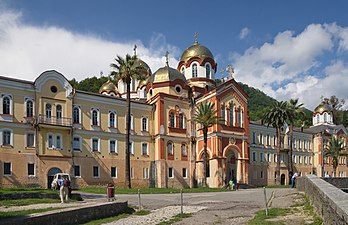









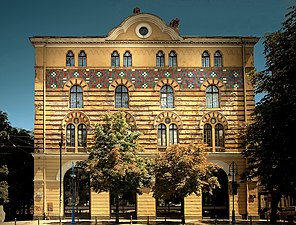
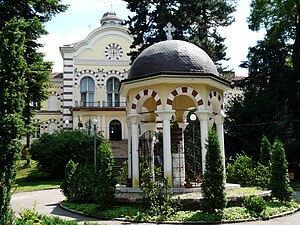



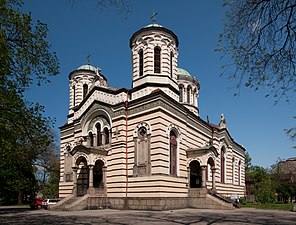



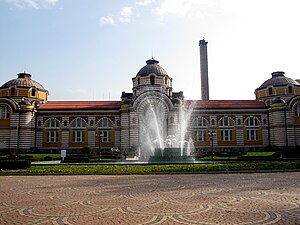

![Entrance of the Laurențiu and Louise Steinebach House (Bulevardul Eroii Sanitari no. 18), Bucharest, by Alfred Popper, 1915-1916[1]](https://upload.wikimedia.org/wikipedia/commons/thumb/4/41/18_Bulevardul_Eroii_Sanitari%2C_Bucharest_%2803%29.jpg/283px-18_Bulevardul_Eroii_Sanitari%2C_Bucharest_%2803%29.jpg)
![Doctor Dobrovici House (Bulevardul Lascăr Catargiu no. 40), Bucharest, by Duiliu Marcu, 1919-1925[2]](https://upload.wikimedia.org/wikipedia/en/thumb/a/a0/40_Bulevardul_Lasc%C4%83r_Catargiu%2C_Bucharest_%2804%29.jpg/286px-40_Bulevardul_Lasc%C4%83r_Catargiu%2C_Bucharest_%2804%29.jpg)
![Doctor Ion and Maria Urlățeanu House (Strada Dumbrava Roșie no. 10), Bucharest, by Alfred Popper, 1922-1923[3]](https://upload.wikimedia.org/wikipedia/commons/thumb/d/d0/10_Strada_Dumbrava_Ro%C8%99ie%2C_Bucharest_%2805%29.jpg/286px-10_Strada_Dumbrava_Ro%C8%99ie%2C_Bucharest_%2805%29.jpg)
![Strada Pictor Constantin Stahi no. 18, Bucharest, by Tiberiu Niga, 1930s[4]](https://upload.wikimedia.org/wikipedia/commons/thumb/9/94/18_Strada_Pictor_Constantin_Stahi%2C_Bucharest_%2801%29.jpg/159px-18_Strada_Pictor_Constantin_Stahi%2C_Bucharest_%2801%29.jpg)


